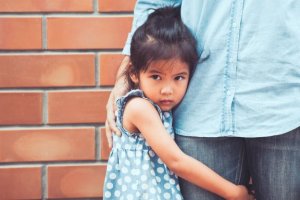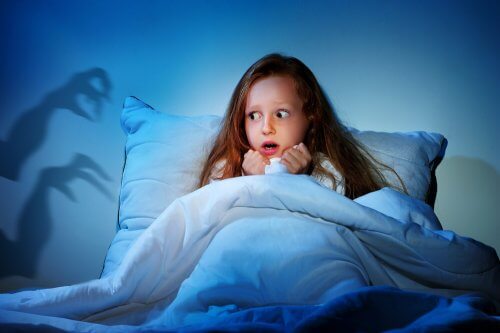The Most Common Fears in Children

Each child can be afraid of different things. That being said, little ones do tend to have certain fears in common. Today we’ll provide a list of the most common fears in children, as well as how to help them overcome them.
Experiencing fears is part of the learning process in children, as is overcoming them. Parents play an essential role in this process, helping their children by providing support and advice to help them face their fears.
The most common fears in children
Fear of the dark
Fear of the dark is one of the most frequent fears in children. It’s also one of the fears that can appear the earliest (around 2 years of age). This is when children become aware that they’re in a dark room.
Suddenly, kids find themselves in a dark room without any light, alone, with their imaginations working against them. Any fear can cause them to panic.
Parents can help their little ones overcome their fear of the dark in a number of ways, as follows:
- Accompany them for some time while they’re in the dark so they understand there’s nothing to fear.
- Place a nightlight on the nightstand so they aren’t in complete darkness.
- Stick glow-in-the-dark star and moon stickers on the ceiling of their bedroom to shine at night.
- Make up stories about the sun, the moon and the stars so that your kids understand that the stars and the moon will always protect them.
Nightmares
Nightmares are also high on the list of the most frequent fears in children. When this occurs, children tend to wake up agitated and, on occasions, screaming and sweating.
What parents must do in these situations is calm their children, explaining the nightmares aren’t real. Rather, they’re part of a child’s imagination and won’t happen again. During these moments, children need their parents’ love and to know that mom and dad are there to help.

Costumes and people that are dressed up
Many children are afraid of people who are wearing costumes. This happens because kids don’t understand that there’s a person behind the costume.
Observing the proportions, colors and characteristics that stand out in costumes cause children to distrust what they don’t recognize.
The solution for overcoming this fear is for the person wearing the costume to show his or her face. That way, children can recognize that there’s a friendly person inside.
Another good idea is for parents to get dressed up with their children to help them lose their fear of costumes and see it as something fun.
Fear of water
Water is yet another common fear in children. However, in many cases, it later becomes a favorite pastime. This fear may be the result of two factors:
- As human beings, we may experience anxiety knowing that we can’t breathe under water.
- A traumatic past experience with water.
To solve this fear, the first thing you need not to do is force your little one to get into the water if he or she doesn’t want to.
You should explain to children and show them how other children and adults get into the water without danger. This will help them understand that they too can do it.

Going to the doctor
Lastly, being afraid of going to the doctor is another one of the most common fears in children. From a young age, we begin to associate doctors with pain.
It’s important to explain to your children what’s going to happen before they go in. That way your kids know what to expect and their anxiety level drops.
The goal behind this explanation is for children to become aware that the doctor is there to help and not cause harm. The way that doctors treat their patients is extremely important in this case. It’s a sensitive moment, so be sure to choose a pediatrician who is patient and kind.
Promising kids that they’ll get a reward if they behave well will also help them gain courage and motivation.
Each child can be afraid of different things. That being said, little ones do tend to have certain fears in common. Today we’ll provide a list of the most common fears in children, as well as how to help them overcome them.
Experiencing fears is part of the learning process in children, as is overcoming them. Parents play an essential role in this process, helping their children by providing support and advice to help them face their fears.
The most common fears in children
Fear of the dark
Fear of the dark is one of the most frequent fears in children. It’s also one of the fears that can appear the earliest (around 2 years of age). This is when children become aware that they’re in a dark room.
Suddenly, kids find themselves in a dark room without any light, alone, with their imaginations working against them. Any fear can cause them to panic.
Parents can help their little ones overcome their fear of the dark in a number of ways, as follows:
- Accompany them for some time while they’re in the dark so they understand there’s nothing to fear.
- Place a nightlight on the nightstand so they aren’t in complete darkness.
- Stick glow-in-the-dark star and moon stickers on the ceiling of their bedroom to shine at night.
- Make up stories about the sun, the moon and the stars so that your kids understand that the stars and the moon will always protect them.
Nightmares
Nightmares are also high on the list of the most frequent fears in children. When this occurs, children tend to wake up agitated and, on occasions, screaming and sweating.
What parents must do in these situations is calm their children, explaining the nightmares aren’t real. Rather, they’re part of a child’s imagination and won’t happen again. During these moments, children need their parents’ love and to know that mom and dad are there to help.

Costumes and people that are dressed up
Many children are afraid of people who are wearing costumes. This happens because kids don’t understand that there’s a person behind the costume.
Observing the proportions, colors and characteristics that stand out in costumes cause children to distrust what they don’t recognize.
The solution for overcoming this fear is for the person wearing the costume to show his or her face. That way, children can recognize that there’s a friendly person inside.
Another good idea is for parents to get dressed up with their children to help them lose their fear of costumes and see it as something fun.
Fear of water
Water is yet another common fear in children. However, in many cases, it later becomes a favorite pastime. This fear may be the result of two factors:
- As human beings, we may experience anxiety knowing that we can’t breathe under water.
- A traumatic past experience with water.
To solve this fear, the first thing you need not to do is force your little one to get into the water if he or she doesn’t want to.
You should explain to children and show them how other children and adults get into the water without danger. This will help them understand that they too can do it.

Going to the doctor
Lastly, being afraid of going to the doctor is another one of the most common fears in children. From a young age, we begin to associate doctors with pain.
It’s important to explain to your children what’s going to happen before they go in. That way your kids know what to expect and their anxiety level drops.
The goal behind this explanation is for children to become aware that the doctor is there to help and not cause harm. The way that doctors treat their patients is extremely important in this case. It’s a sensitive moment, so be sure to choose a pediatrician who is patient and kind.
Promising kids that they’ll get a reward if they behave well will also help them gain courage and motivation.
All cited sources were thoroughly reviewed by our team to ensure their quality, reliability, currency, and validity. The bibliography of this article was considered reliable and of academic or scientific accuracy.
- Ollendick, T. H.; King, N. J.; Frary, R. B. (1989). Fears in children and adolescents: Reliability and generalizability across gender, age and nationality. Behavior Research and Therapy. 27:19-26
- Pelechano, V. (1981). Miedos infantiles y terapia familiar. Valencia: Alfaplus.
- Sandín, B., & Chorot, P. (1998). Dimensiones de los miedos en niños: Estructura factorial del FSSC-R. Psiquis, 19(1), 23-32. https://www.researchgate.net/profile/Bonifacio_Sandin/publication/285732793_Dimensions_of_fears_in_children_Factor_structure_of_the_FSSC-R/links/59ad46e0458515d09ce16c65/Dimensions-of-fears-in-children-Factor-structure-of-the-FSSC-R.pdf
- Sandín, B., Chorot, P., Valiente, R. M., & Germán, M. Á. S. (1998). Frecuencia e intensidad de los miedos en los niños: Datos normativos. Revista de Psicopatología y Psicología Clínica, 3(1), 15-25. http://revistas.uned.es/index.php/RPPC/article/view/3853
- Valiente, R. M., Sandín, B., & Chorot, P. (2002). Miedos comunes en niños y adolescentes: Relación con la sensibilidad a la ansiedad, el rasgo de ansiedad, la afectividad negativa y la depresión. Revista de psicopatología y Psicología clínica, 7(1), 61-70. http://revistas.uned.es/index.php/RPPC/article/view/3922
This text is provided for informational purposes only and does not replace consultation with a professional. If in doubt, consult your specialist.








